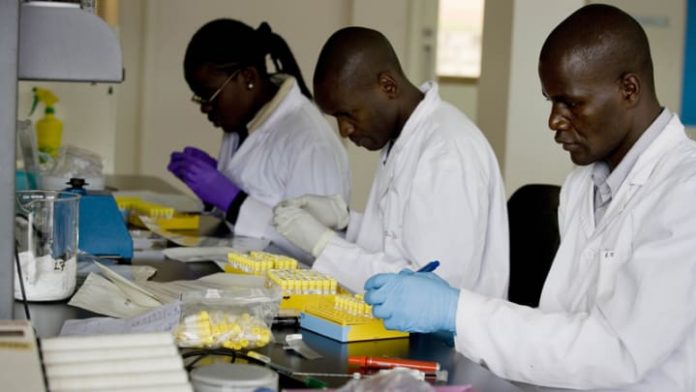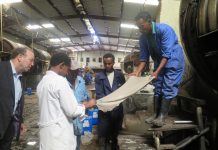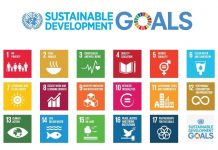The way we were
When I think about African agricultural development today, I cannot help but remember how promising things looked some 30 to 40 years ago. At the time, we felt we were at the start of a golden age for African agriculture.
We had universities with agricultural faculties, research centers and research stations we could be proud of. Our graduates at universities in Egypt, Ghana, Kenya, Morocco, Nigeria, Senegal and Uganda were some of the best in the world, and students came from abroad to study here.
Kisangani, in Congo DRC, was a city of research. The research we did for the Africa-wide Biological Control Program helped save at least 20 million lives in the cassava belt of sub-Saharan Africa. It also saved more than US$2 billion in production. The total cost of the program was only $20 million.
In the sixties and seventies, many African countries were net exporters of major food and cash crops, not importers as they are today. About 20 percent of national budgets at that time went to agriculture. It felt like Africa was on the cusp of eliminating poverty and hunger, and taking its place in the world of research and development.
These were the years when India was described as a hopeless case; when people in China died of famine; Brazil was dependent on food aid and massive food imports; and South Korea received assistance from some African countries.
I, and others here today, well remember the groundnut pyramids in Kano; the bales of cotton in Bornu, Kano and Sokoto; the rice fields of Abakaliki, Nigeria, and Korogho and Man, Côte d’Ivoire; the floating timber along the West African coast; expanses of oil palm here in Ghana, as well as Nigeria and Côte d’Ivoire; not to mention tea plantations of East Africa.
What happened to them?
Stagnation and decline
Over the past three decades, agricultural productivity in Africa has been stagnant or in decline. Why? Because of years of under-investment and an ill-advised structural adjustment.
The resulting waste of so much human life and potential is not only tragic; it is a disgrace because there is simply no reason for it. We know what needs to be done. And we know what can be done.
There are encouraging signs that African nations are once more focused on investing in agriculture for growth. The development of a Science Agenda for Agriculture in Africa under the auspices of FARA is an important step on the road to a strong agricultural sector. It is all the more important because it is Africa-owned and Africa-led. It holds the promise of African farmers and citizens reaping the benefits of African research. But it will only translate into stronger nations and better lives for the people of Africa if it is supported by coherent investment in agriculture for development.
There have been some encouraging developments. NEPAD’s Comprehensive Africa Agriculture Development Program promises to strengthen food production and security. A number of countries have now met or exceeded their Maputo Declaration target of spending 10 percent of national budget on agriculture. Many more now have strong agricultural development and financing plans.
But we still have much work ahead. The task ahead of us is more complex than it was 30 years ago. Food prices are higher and more volatile than ever. The world’s population is heading toward 9 billion, with much of that growth in Africa. Climate change, higher temperatures, prolonged droughts, extensive flooding are now forces to be reckoned with. To make matters more complicated, the fragility of many countries has been worsened by conflict.
The great and tragic irony of all of this is that, globally, we already produce enough food to feed every child, woman and man on this planet. Not just for today but for the foreseeable future. But food is not getting to the people who most need it.
A holistic approach
When we consider the challenges and opportunities for African agriculture, we must look at the whole picture. If we set our sights only on improving productivity, there is a very real danger that we will grow more food in Africa without feeding more people.
Let me be clear. There are many opportunities in African agriculture today. But in order for agriculture to yield the greatest returns for Africa, development efforts must focus on the smallholder farming sector. Small farms account for 80 percent of all farms in sub-Saharan Africa. In some countries, they contribute up to 90 percent of production. They have the potential to be key suppliers to Africa’s burgeoning urban markets, as well as supplying rural markets.
Successful small farms can create vibrant rural economies with a range of non-farm enterprises, providing a variety of jobs, decent income and food security. In areas where the terrain and socio-political structure are conducive to larger farms, these too can contribute to greater development, but only if investment is transparent and responsible, and if strong links are forged with the smallholder sector.
With these issues in mind, we must ask ourselves, do we want to get back on the road that we left in the 1970s, or do we need a new road?
I would argue that our approach must be entirely different. We must reposition research and development so that it is research for development. This means measuring our results NOT by higher yields alone, but by reduced poverty, improved nutrition, cohesive societies and healthy ecosystems. In short, it must be inclusive.
Science and technology
We must be bold in pushing the frontiers of science, innovation, knowledge and experimentation and not shy away from questioning the logic and sequence of events and processes, even when this means challenging scientific conventional wisdom — we must be open to investigation, to thinking outside of the box.
We must also accept that scientific ideas and discoveries are not the purview of scientists alone. As scientists, we know the value of observation. Sometimes, those best placed to observe are the people on the ground.
We must also be careful not to get carried away by a desire to always be at the cutting edge of modern technology. Certainly, new breakthroughs have their place in agricultural development. Agricultural biotechnologies, including Marker Assisted Selection, Marker Assisted Breeding, tissue culture and embryo rescue techniques offer many benefits. They can boost productivity, improve the tolerance of seeds and plants to drought, temperature stress and pests, and make nutrient use more efficient.
But we must recognize that technology is only a tool. It is not an end in itself. As a scientist, I understand the excitement of new discoveries. But as a development practitioner I have seen the miracles that take place when we give farmers the tools to enhance existing – and sometimes quite traditional technologies.
It is true that breeding new crop varieties drove the first Green Revolution, but we should not forget that high yielding varieties are only one part of the farming system. Basic farming system research in natural resource management, conservation agriculture or simple agronomic practices are all part of innovation into sustainable intensified production systems.
Often, simply optimizing conventional approaches, such as the use of fertilizers and micro-irrigation, or using trees to improve soil fertility and moisture content, yield dramatic results. Indeed, there is huge potential to increase yields using low cost and existing technologies.
In Africa, only about 6 percent of the total cultivated land is irrigated. This compares with 37 percent in Asia. It is estimated that irrigation alone could increase output by up to 50 percent in Africa. Similarly, farmers in sub-Saharan Africa use less than 13 kilograms of fertilizer per hectare. In contrast, farmers in the Middle East and North Africa use about 73 kilograms, while farmers in East Asia and the Pacific use 190 kilograms.
Small increases in fertilizer use in sub-Saharan Africa can produce dramatic improvements in yields. We have seen good results from a fertilizer micro-dosing technique developed by ICRISAT and its partners, using a bottle cap system so farmers can measure out small, affordable amounts of fertilizer. And in addition, greater use of high-yielding seed varieties could have great benefits.
The potential
What does all of this tell us? It tells us that what we might call “subsistence agriculture” is basically an under-performing agricultural system. This is not a challenge. Rather, it is an opportunity. It means we have yet to optimize our agricultural potential by maximizing existing conventional technologies and systems, not to mention the tremendous opportunities waiting to be exploited in unused agricultural land.
Africa has the largest share of the world’s uncultivated arable land. This is why foreigners are taking notice. Let us take advantage of this opportunity and let us not sell off our land blindly.
There are 800 million hectares of uncultivated land with rain-fed crop potential in sub-Saharan Africa, and virtually none in South and East Asia or North Africa. Simply providing smallholders with fertilizers, improved seed and access to irrigation is half of the equation.
The other half of the equation for food and nutrition security includes the right policies, investment in rural infrastructure and access to land and local, national regional markets. And here I shall emphasize that Africa’s research for development does not give enough attention to policy issues and the social dimensions of development. This must change if our goal is for long-term, sustainable, transformational development.
To put it simply, Africa needs a commitment at all levels, involvement of all sectors of our societies — government, the private sector, farmers themselves, NGOs, civil society, and particularly women and young people. If governments truly want agriculture to have a profound impact on poverty and hunger, they must invest in rural infrastructure. Farmers need processing and safe storage facilities so they are not forced to watch their harvested crops be eaten by pests or spoil in uninsulated sheds.
Today, more than one third of the rural population of sub-Saharan Africa lives five hours from the nearest market town of 5,000 people. Little wonder that it costs 5 times as much to transport a ton of rice in parts of Central Africa than it does on major routes in Pakistan.
The lack of viable market outlets condemns too many of Africa’s farmers to subsistence agriculture.
Farmers need roads that are not only paved, but able to withstand more frequent and extreme weather. They need access to rural financial services so they too can invest in their agricultural businesses. And they need reliable access to electricity and clean water, as well as links to markets and information.
What this means is that for Africa to feed Africa, it is not just the job of the Ministry of Agriculture. It is a whole government affair: Agriculture, Finance, Planning, Infrastructure, Trade and Industry, to the President itself.
Prevention vs. intervention
It is critical that our research and development efforts respond to the reality on the ground. For example, about half of sub-Saharan Africa’s agricultural labor force are women. Yet too often women are the most disadvantaged members of rural societies.
To farm successfully, women need agricultural resources and inputs, as well as access to rural finance, education, and knowledge. They also need rights to the land they farm and a voice in the decisions that affect their lives.
Higher productivity and income do not automatically lead to improved nutritional status. A child cannot grow into a healthy adult on a diet of cassava alone. Gari in the morning, eba for lunch and fufu for dinner.
For too long, we have relegated under-nutrition to the intervention level, and left it to the Health Department. Yet prevention is far better and much cheaper than the cure. Helping poor farmers to improve nutrition by diversifying their farming systems and planting household gardens is as important in preventing under-nutrition as any intervention. Agriculture for nutrition and growth were themes at the recent pre-G8 meetings.
Science can lead to more nutritious crops, such as Quality Protein Maize, which are widely used by farmers and are reducing malnutrition among adults and babies in developing countries.
Agriculture is not just crops alone, and science can also lead to productive livestock and crop integration, aquaculture and fish-crop farming and ways of generating income through agriculture while also meeting nutritional needs.
With all the attention to climate change and climate-sensitive agriculture, we have a duty to ensure that short-term gains do not deplete the land and the resource base. We need to reverse deforestation and encourage afforestation and reforestation. We need to improve land-management practices such as agro-forestry, and the rehabilitation of degraded crop and pasture land.
And in the years ahead, more research will need to be directed towards agricultural growth that is ecologically sustainable and that provides a diverse range of options, genetic variation and ecosystems so that the land can provide for future generations of farmers.
Who is better placed to know the conditions on the ground in Africa, and to discover solutions to the challenging conditions in Africa, than African scientists themselves? But for our scientists to be world class and competitive, they must go beyond the traditional path of acquiring advanced degrees and diplomas from the developed world. They must take their knowledge — whether acquired abroad or at home – and put it to work.
Redefining partnership
As I advocate for more investment in research, I also stress that research for the sake of research is wasteful and pointless. Research, ultimately, needs to have an application.
Our job – indeed our moral imperative — is to ensure that research serves the needs not just of agricultural development, but of social and economic development. We must give smallholders the tools they need, and create the conditions for them to be able to benefit from the very real opportunities in agriculture.
All of this boils down to one thing: A shift in paradigm. We should redefine what we mean by partnership.
What is the role of government? What is the role of civil society, the private sector, NGOs, farmers and the development community? Are we working at cross-purposes or adding value to a common agenda? According to some estimates there are over 350 organizations providing development assistance to Africa with a plethora of projects. Today we have Grow Africa, GAFSP and G8 New Alliance. Grow Africa is creating opportunities for the private sector to invest in Africa. We should be sure that the domestic private sector is also part of this partnership.
Our challenge is to take what we know works, to develop what we know is needed, and to apply our knowledge, country-by-country, region-by-region. If we do this, not only will Africa feed itself, it will contribute to global food security, economic growth, wealth creation, and global peace and stability.
Kanayo F. Nwanze, Ph.D., is president of the International Fund for Agricultural Development. The above is an edited excerpt of his speech at the 6th Africa Agriculture Science Week and general assembly of the Forum for Agricultural Research in Africa (FARA). July 2013, Accra, Ghana.













